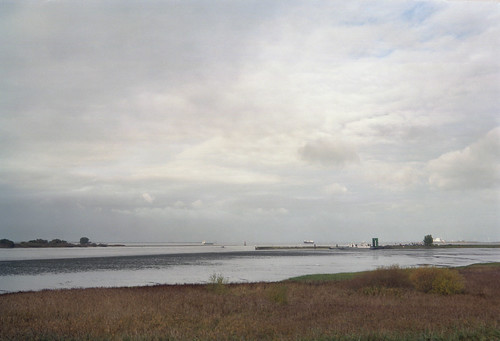
That character inside the room, Wilhelm, is played by Rüdiger Vogler, in his second appearance in the ‘road movies’ trilogy. As the helicopter is seen passing the spire of a church on the far side of the town square, the sound of the rotor blades is replaced by the music Wilhelm is listening to on the record player. The second shot is completed by one song ending, and Wilhelm moving away from the window to put the needle of his record player down and another track begins (or, it would appear by the small movement he makes with the tone arm, he is playing the track which just ended again). Wilhelm moves back to the window. There is a cut to a detail of two figures crossing the square below, the frame being interrupted by Wilhelm’s fist smashing the window. The figures look around and up - one is blind - and from outside, we see Wilhelm smashing the other window with his other fist. He then turns off the record player with one bleeding hand; his mother enters the room, looking at him without speaking and then leaves. Wilhelm throws the record sleeve into the corner of the room and pulls up the blind on the second window as a fade to black begins, thus ending the opening scene.
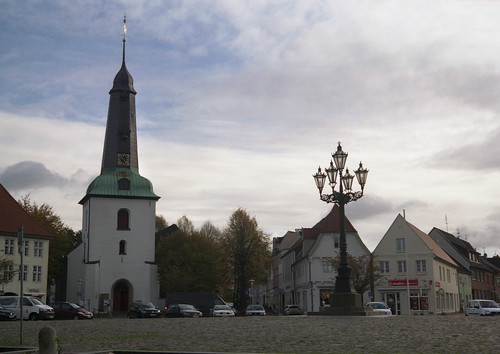
As the film unfolds, Wilhelm, the male protagonist of this road movie, does not drive: he cycles, is driven in a taxi, in cars by other (female) characters, and notably travels by train. In contrast to Alice in the Cities, but especially Kings of the Road, this suggests a lack of volition, that Wilhelm is not directly in control of his destiny, cast out by his mother, subject to the whims of fate or fortune, and comes under the influences of those he encounters. Rüdiger Vogler’s next role, in Kings of the Road, seems to be a deliberate corrective to his Wilhelm Meister: here, he’s often sullen, introspective to the point of ignoring his companions’ needs, unable to act on his desires. On the surface, Vogler appears too old for the role, past thirty. In an interview where he discusses Alice in the Cities, Wenders, speaking in English, describes Vogler as his "elder ego”, labouring on how the phrase alter ego is a pun that works in German. The actor, being three years older than the director, is however part of the same generation that grew up in post-war West Germany, a generation without fathers both literal and figurative; no father appears or is mentioned in the film, although with the characters he meets Wilhelm does form a structure that is like an ersatz family unit. There appears to be a deliberate infantilism of the character, a quality of being stunted, impotent and a sense of delayed or suspended adolescence, in the relationship with his mother, in the clothes Wilhelm wears, and in the fact that the records seen in his room are several years old, holding on to the trappings of youth. The two records explicitly seen and heard are the Kinks’ eponymous 1964 debut album, and the Troggs’ ‘Wild Thing’ from 1966, rock and roll by one remove, American sounds via Britain, although for Wenders there was a personal relevance in this music:
“… rock and roll shook a whole generation out of its isolation, and not only did it free it from something, but it also brought it to something- namely, the realization of its own creativity. That was what was so fantastic about the rock and roll of the sixties, in particular the eruption of English rock- it opened people up to the pleasures and possibilities of their own imagination. Those British rock musicians whose music we grew up to, that second wave of rock that happened in my own generation- Chuck Berry, Elvis, and the other early rock stars were all before my time- they were people like me, art students and the like, who had no real direction. And when they began to make music with so much force and electricity that it spread like wildfire, it ultimately led me to take my life into my own hands.”Yet, for Wilhelm, alone in his room, this music appears to only highlight his isolation, and it’s also cut to provide emphasis, according to Edward Plater’s reading:
Wim Wenders, in conversation with Taja Gut, from The Cinema of Wim Wenders: Image, Narrative and the Post Modern Condition
“Wilhelm goes over to the phonograph, restarts the record […] and returns to the window, as we hear, ‘When my luck is down .... On the word ‘luck’ there is a cut to a shot from Wilhelm's vantage point of the couple walking past the window. After the word "down," Wilhelm's right fist goes through the glass […] Smashing the window panes with his fists, even though it provides an outlet for his pent-up emotions, is nevertheless the first in a series of ‘wrong moves’ that Wilhelm makes in the course of the film."Falsche Bewegung has been variously titled in English The Wrong Movement, The Wrong Move, or simply Wrong Move. Falsche, it would appear, can be equally translated into English as false, which has a different emphasis from simply being wrong - false in the sense of something covering up, imitating something to deceive - and perhaps in the case of Wrong Move, to self-deceive. In Peter Handke’s script for Wrong Move, Heide is specified for Wilhelm’s home town, but, as filmed, Wenders used nearby Glückstadt. Richard W. McCormick, in ‘The Writer in Film: Wrong Move’, expanding on the transition from script to film, describes this choice as having greater resonance from being on the Elbe, “not just any river, but the one that symbolizes Germany’s postwar division into two states. The north-to-south journey through Handke’s script is thus given a starting point that grazes, if ever so briefly and indirectly, the east-west rupture that was so much more a determining factor of postwar German political realities than the much older north-south split in German culture.” McCormick goes on to describe how Wilhelm’s initial destination for his train journey south changes from Soest in the script, to Bonn in the film, “the sleepy, midsized town chosen in 1949 as a temporary substitute for the metropolis east of the Elbe.” The town’s name also has pertinent associations: it can be translated as ‘luck’ or ‘lucky town’. Perhaps more appropriately, this could be also be ‘fortune’, and indeed the town’s emblem is the iconographical figure of Fortune balanced on a sphere. In the film, Wilhelm is a character with a ‘fortune’ to make, but, in not having to worry about money itself, this 'fortune' is his ambition to be a writer that his journey is to provoke. Finally, the choice of Glückstadt as a location evokes qualities of Heimat that Heide would also have had, but in less overdetermined ways.
Edward Plater, ‘Taking another look at Wim Wenders's Wrong Move’

The small town that can be glimpsed in its totality from the helicopter exudes a sense of permanence. Unlike the two other road movies Wenders made either side of Wrong Move, Wilhelm has a home, a Heimat. A comparison to the domestic situations of Vogler's characters in the other films in the loose trilogy is instructive: in Alice in the Cities, Philip Winter begins the film at the far side of America and has no apparent home, although he talks about his parents, and that he will take Alice there just before the police find them; Bruno Winter is entirely peripatetic in his van in Kings of The Road, while his hitchhiker Robert tears up his photograph of home at the very beginning of the film. The architecture in the town square in Wrong Move appears barely touched by the 20th century (in contrast, the Zimmermanns’ apartment in The American Friend is surrounded by flattened areas of Hamburg from bombing thirty years before), although modernity is creeping in: Wilhelm’s mother is “selling out to a supermarket”. Forty-two years later, I was in Glückstadt on a Sunday morning at the end of October when the clocks had just changed. It was easy to see exactly how little the town has changed; the house used for Wilhelm’s home in the film stands on Marktplatz in the centre of the town. Unlike Wuppertal or Hamburg, there’s no Google Street View at the time of writing, but the aerial shot at the beginning of Wrong Move makes for easy comparison to satellite images and contemporary maps.
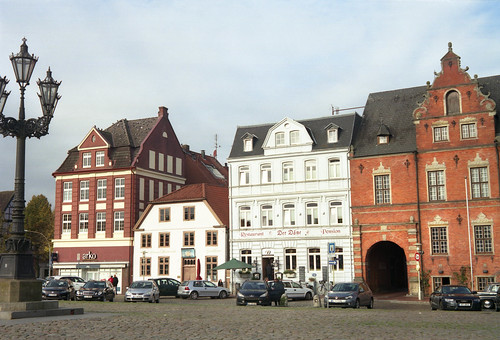
Wilhelm’s room is on the third storey of a white building that currently hosts a restaurant, Der Dåne (Glückstadt was Danish until the wars that resulted in the unification of Germany in the mid-19th century); the stucco moulding under the windows on this floor are clearly the same as in the film. The reverse angle shot of Wilhelm from the street level is tightly cropped, making it difficult to identify exactly which particular window he smashes, but shots from the window out onto the main square with its distinctive church spire help: using the angle of Grosse Nübelstrasse, a street on the far side of the square opposite, which can be seen down to the end, but in perspective, the left hand side of the street almost closes the view. From ground level, I estimated that of the five windows in a row, it was most likely the second from right.
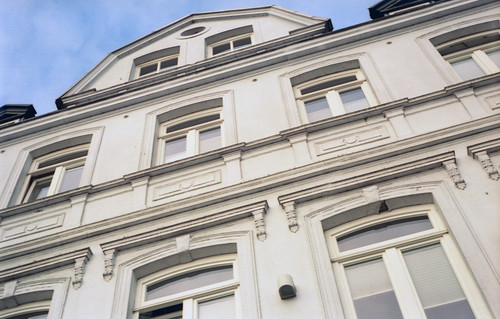
The representation of home in Wrong Move as something to be escaped from, as an atmosphere that suppresses creativity does appear to bear a structural relationship to the kind of films that the New German Cinema was reacting against. In the immediate post war period, a small number of Trümmerfilme or ‘rubble films’ were made in the ruins of Germany, but with the establishment of the Federal Republic by the Allied powers, a new type of film was needed for the new state. During the 1950s, films were made that catered: “expressly for German audiences and mostly comprised Heimatfilme - homeland films - which depicted simple country life in a rural Germany, adventure films based on popular German novels, historical films set in imperial Austria, together with romantic adventures and comedies set in picturesque locations.” (Julia Knight, New German Cinema: Images of a Generation). These films, which “would take viewers from sites of devastation, both physical and psychic, to consoling prospects of verdant countryside and intact village communities,” in the words of Eric Rentschler, “played a crucial role in the restoration of Germany; it both accompanied and participated in the economic miracle.” It was this cinema of the 1950s that provoked the Oberhausen Manifesto, a reaction to the consoling films of an older generation of directors, technicians and actors that had largely worked in the studios under the Ministry of Propaganda before and during the war. Although not entirely uncontested as a founding document for a Stunde Null or year zero for a national cinema, as described by Rentschler, the Oberhausen Manifesto of 1962 did have the effect that its twenty-six signatories desired: it brought forth the funding structures that provided the foundations of the Young German Film which followed and matured into the New German Cinema of the 1970s, of which Wenders played a significant part.
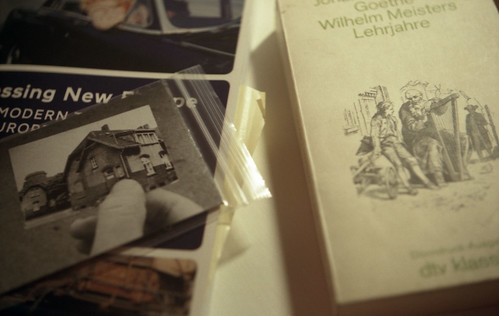
As well as situating its protagonist’s home in a small town in rural Germany, Wrong Move is loosely adapted from Goethe’s Wilhelm Meister’s Apprenticeship, thereby falling into the category of “adventure films based on popular German novels”; however, rather than providing an escapist, consoling narrative, Handke’s adaptation of Wilhelm Meister essentially becomes anti-Romantic, especially with Wenders’ direction, as described in McCormick’s ‘The Writer in Film: Wrong Move’, further complicating, or even working against the script itself. Although there are some precedents, with Wilhelm Meister’s Apprenticeship, Goethe laid the foundations that defined the Bildungsroman, or novel of formation, but for Wenders and Handke, this ‘formation’ is no longer possible except as an empty gesture: in Wilhelm’s movement through Germany and his encounters with the other characters, and the landscape itself, he appears to learn little, or little of these encounters significantly affects him; notably, at two key moments in the film when Wilhelm is called or moved to action, he is impotent. In Goethe, Wilhelm is sent away from home on family business, which he abandons to pursue his theatrical ambitions after falling in with some travelling players, and he deliberately dissembles in his letters home to assure his father that he’s fulfilling his duty. Fatherless in Wrong Move, Wilhelm’s mother talks about smoking, drinking martinis and reading his letters, vicariously experiencing his travels from the comfort of home.
"I want you to go away."Of the three road movies that form the loose trilogy, Wrong Move is by far the most verbose, not only in the dialogue between characters, but also in the use of Wilhelm’s voiceover which dominates sections of the film and provides a commentary set at one remove from the action - as if Wilhelm is recollecting these events with the passage of some unspecified interval of time. Wim Wenders’ and Peter Handke’s sensibilities were sympathetically aligned during the period of their closest collaborations, and while comparisons have been made between aspects Handke’s novel Short Letter, Long Farewell to Alice in the Cities (travelling across America with a small child, the references to John Ford and Young Mr Lincoln, and, indeed, Canned Heat and 'On the Road Again'), for me, the emotional tenor of the novel’s (unnamed) first person narrator resonates strongly with Wilhelm’s voiceover in Wrong Move:
"I'm selling out to a supermarket. You'll get some of it."
"No..."
"Don't say anything William dear. Wait to you have to. And don't lose that unrest and discontent of yours. You'll need it if you want to write."
“It wasn’t company I wanted, I only wanted to be rid of myself. The slightest contact with myself was disagreeable; I kept my arms as far away from me as possible. The moment I felt my body heat in a chair, I moved to another. After a while I had the impression that I had warmed all the chairs, so I just stood. It shook me to think that I had ever masturbated. I went about with my legs far apart, so as not to hear the rubbing of my trouser legs. Don’t touch anything! Don’t see anything! Can’t somebody knock at the door! A horrible thought: to turn on the TV and hear voices, see images! I went to the mirror and made faces at myself. I wanted to stick my finger down my throat and vomit until there was nothing left of me. To hurt myself, maim myself! I paced the floor, forward and backward. Or open a book and read some loathsome sentence! Or look out the window and be confronted again with SNACK BAR, TEXACO, ICE CREAM! Shut everything up, cast everything in cement! I lay down on the bed and piled all the pillows on my head. I bit the back of my hand and thrashed around with my feet.
’Time drags so.’
That sentence from a story by Adalbert Stifter ran through my head. I sat up and sneezed. It seemed than in sneezing I had leaped over a long stretch of time. Then I wished something would happen to me as soon as possible.”
Peter Handke, Short Letter, Long Farewell
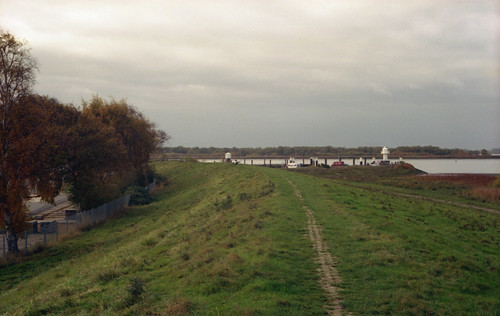
Before Wilhelm leaves Glückstadt, he spends some time in a house on a beach, to which he is seen cycling, and taking a ferry across a river. Although I attempted to identify this, I wasn’t able to securely locate it; walking along a straight road from Marktplatz to the bank of the river, there is a ferry across the Elbe, but this appears rather more built up in its surrounding infrastructure than the small cobbled road that Wilhelm cycles along - and the river is wider. In the film, it appears that Wilhelm crosses the Stör, a tributary of the Elbe just north of Glückstadt: in the shot showing the ferry, a sign can be seen with the words “Nächste Störbrücke Itz-“, the partly visible word surely Itzehoe, a town just upstream. From the window of the beach house, the viewer can see another similar house some distance off, and two figures walking together on the beach, one in a raincoat, the other in red, just like the blind man and his companion from the first scene of the film. Wilhelm appears not to notice that connection, instead we hear his voiceover as he is writing:
"I'm not desperate, just listless and fed up."Richard W. McCormick explicitly links Handke, Wenders and Wrong Move to Erfahrungshunger, a malaise affecting the West German post war generation after the failure and betrayal of 1968. Erfahrungshunger, translated as ‘hunger for experience’, was the subject of a book length essay by Michael Rutschky, subtitled Ein Essay über die siebziger Jahre. The “unrest and discontent” that Wilhelm manifests is a symptom of this hunger. In the absence of an English translation of Rutschky’s book, it’s worth quoting at length from Eric Rentschler’s description of the concept:
"It's as if I had no tongue."
“Describing the widespread disaffection that attended the demise of the student movement, Rutschky, saw a collective shift from a will to enact theoretical constructs to a desire to remain undefined by social mechanisms. With the melancholy resulting from the collapse of a leftist public sphere came a retreat into a lonely subjectivism. If anything, this new sensibility (which was referred to at the time, often disparagingly, as the “Neue Innerlichkeit” or the “Neue Subjektivität”) was out of touch with everything and everyone. The cinema, in this context, provided a welcome refuge from a threatening material world, where objects, otherwise functionalized and commodified, gained new immediacy and tangibility, where one, in general, could breathe more easily. In the dark, one experiences a dreamlike fascination while enjoying the intensity of isolated images: The corporeal world comes alive, freed from the conditioning forces that structure the everyday, liberated from the discursive frameworks that bind certain signs to particular associations, redeemed in that it comes to be felt and experienced in all its sensual richness. In the cinema, the world stops making sense and in that way takes on new meanings, meanings [Siegfried] Kracauer had appreciated and elaborated in his Theory of Film.”A concise critique of this ‘New Subjectivity’ is given in the introduction to Short Letter, Long Farewell, by an unnamed editor to whom Greil Marcus had given a copy of the novel: “‘It’s one of those books where the narrator is taking his emotional temperature every two minutes,’ he said. ‘Who’s got time for that?’”
Eric Rentschler, ‘Hunger For Experience, Spectatorship, and The Seventies’ in The Use and Abuse of Cinema
One could argue for the explicit situating of the aerial shot that opens the film by the rain and its reverse angle reveal is a foregrounding of this ‘New Subjectivity’, that Wenders did not feel able to use an apparently objective shot over the town, and it needed to be placed. As fits Wrong Move’s anti-Romantic subtext, there is a suggestion that in cinema the appearance of omniscient view is suspect: Wenders’ cinema here is “… much too honest to efface the traces of its own construction.” Richard W. McCormick, ‘The Writer in Film: Wrong Move’; the script for the film begins with an establishing shot of the town square (presumably in Heide); Wenders use of the aerial shot was his method to link Wrong Move to his previous film, but with an intention to provide a filmic commentary on this convention.
The night before leaving, there is a brief scene of dissatisfaction between Wilhelm and his girlfriend, Janine, played by Lisa Kreuzer. Janine works in the cinema, which was previously seen as Wilhelm cycles across the square on his way to the beach house. There, in the background, the title of the film displayed on the marquee can be read: Die Ruckkehr Der Reitenden Leichen. A literal translation of the title would be 'The Return of the Mounted (or Riding) Corpses', which is given by Edward Plater in ‘Taking another look at Wim Wenders's Wrong Move’, and he suggests it as a fortuitous comment on the cultural atmosphere of the town “whose central square is devoid of activity and whose nearby beach is all but deserted” and that Wilhelm’s presence cycling past the cinema links him to the riding dead “and whose indifference and apathy, which become increasingly apparent as the story proceeds, approximate the condition of a corpse”. However, this film, the second in a series of Spanish horror movies by Amando de Ossorio was released in English as The Return of the Blind Dead (it was also known as Return of the Evil Dead, although not to be confused with the more famous franchise). This minor detail is one more layer of overdetermination: the original Spanish title, El ataque de los muertos sin ojos, explicitly refers to ‘without eyes’, “sin ojos”. The repeated references to blindness around Wilhelm - the blind man in the market square, the ‘blind dead’ of the horror film, indeed the rain on the helicopter window occluding the view and making the opening image less clear - imply that Wilhelm is lacking in sight, that he needs his eyes opening. Wilhelm later describes himself as possessing an ‘erotic gaze’ (“erotische Blick”) but without marrying this gaze to a deeper understanding of others, contained within his radical Innerlichkeit, his desires to become a writer would appear to be thwarted.
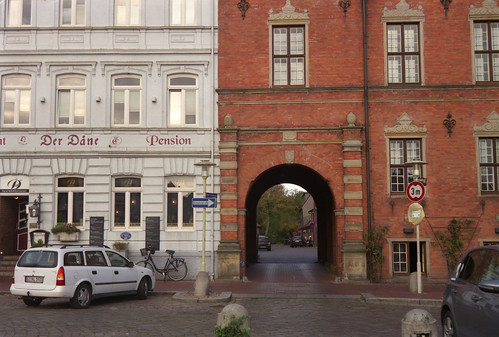
The cinema in Wrong Move is clearly on Marktplatz, and Wenders explicitly mentions in the DVD commentary to the film that it’s in the same building as Wilhelm’s apartment - but neither are shown together in a single shot. There may have been many reasons for Wenders not showing this building in a wider angle, which would demonstrate the proximity of the cinema to Wilhelm’s room, and doing so may have enhanced the claustrophobic atmosphere of the small town, yet this is lacking. The cinema itself has disappeared, although it is just possible to see a trace of its entrance in the different stucco moulding over the two ground floor windows on the right hand side of Der Dåne restaurant. The side door where Wilhelm meets Janine is still there, in the alleyway of the adjoining brick building on Kleine Schwibbogen. Lisa Kreuzer, as Janine, appears as a symbol of both the corrupting power of commercialised images, promoting the cinema in a wig and what appears to be a Japanese silk dress under her dun-coloured overcoat, and as a symbol of the domestic, the second of two generations of women that Wilhelm is escaping. On the Axiom DVD of Wrong Move, there’s an extra feature, ‘On the set of Wrong Move’, which is a compilation of super-8 footage: as well as showing the helicopter from the opening of the film, this also has a shot with the cinema on Marktplatz, but here the marquee lettering reads “Jim Brown is Slaughter”, a 1972 Blaxploitation film. These films are indicative as to the kind of product available in small town cinemas at the time, critiqued by Wenders in ‘Despising What You Sell’; the appearance of cinemas in Wrong Move, here in Glückstadt, and then later in Bonn and Frankfurt, provided the germ of the idea for the next film in Wenders’ trilogy, Kings of the Road.
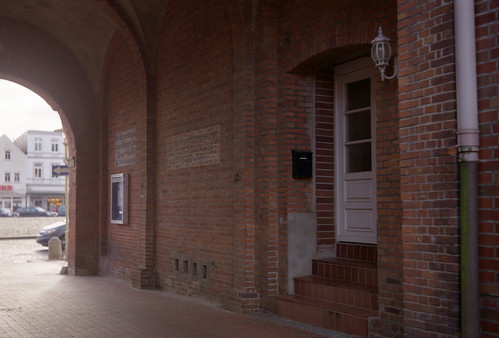
This scene cuts to a brief shot of ship at sea, apparently unrelated, which fades into Wilhelm sleeping, indicating the previous shot as a dream. Although the characters Wilhelm meets on his journey later tell each other their dreams, this is the only one represented visually on the screen (in another parallel, the narrator in Handke’s Short Letter, Long Farewell frequently describes his dreams). Wilhelm, who had earlier stated that he had not spoken in two days, but recalls that his mother told him he talked in his dreams. Here he murmurs “Im Lauf der Zeit…” - in the course of time - which became the German title of Wenders’ next film, known in English as Kings of the Road.
Wilhelm’s suitcase has been packed by his mother. On top are two books: The Life of a Good-for-nothing (Aus dem Leben eines Taugenichts, 1826) by Joseph Von Eichendorff and Flaubert’s Sentimental Education (the German title of which might remind one of Goethe’s Wilhelm Meister). Both examples of the genre of Bildungsroman, The Life of a Good-for-nothing (sometimes translated as 'Ne’er-do-well') is no doubt less well known to English language readers, but its narrator - like Wilhelm - does not appear to learn anything from his travels, yet through his carefree, happy-go-lucky attitude, succeeds. Another literary reference in the film is William Faulkner’s Mosquitoes, Wenders’ favourite book at the time according to his DVD commentary, which is seen propped up when Wilhelm’s mother appears in the very first scene (in Kings of the Road, Bruno is reading Faulkner’s The Wild Palms).
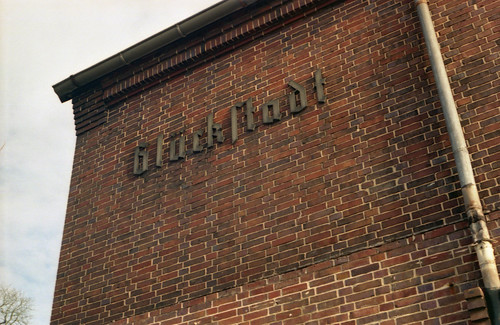
Wilhelm and his mother take a taxi to a railway station. In reality, the station in Glückstadt would not be far enough for a taxi; it’s barely five minutes walk from Marktplatz. However, the building in the film is very different from the station that I arrived at: my first thoughts were that either Wenders used another station in Wrong Move or the station in Glückstadt has been rebuilt since. The current building is difficult to date, being a relatively simple brick structure with some vernacular aspects. In the film there is a large open field to the right of the station; in Glückstadt, the station is adjacent to the Stadtpark, but it looks quite unlike that in the film. As the train leaves there is a second aerial shot, which appears to show Brunsbüttel, another town further north on the Elbe, which makes the taxi journey logical in itself. The rail route to Hamburg that Wilhelm takes passes through Itzehoe, the station name just visible in a very brief shot, which initially made no sense, as this is north of Glückstadt, although the reason for not travelling from Glückstadt station itself is still unclear.
There are three drops of blood on the seat opposite Wilhelm when he sits down. We later learn this blood to belong to a man that Wilhelm has just passed entering the carriage. The theme of blood repeats throughout Wrong Move, first with Wilhelm’s hands, then the nosebleed of his fellow train passenger, and later, the industrialist jabbing a pen into his hand - a pen which Wilhelm retrieves to write with. The passenger with the nosebleed that Wilhelm refers to in voiceover simply as ‘the old man’ is named Laertes in the credits to the film; he is also accompanied by Mignon, both of these are names of characters from Goethe’s Wilhelm Meister, Laertes in turn being a reference to Hamlet, which is discussed in Goethe’s novel. Wilhelm looks from the blood to Mignon, who in turn looks from Wilhelm to the blood, which is then seen in close up. Wilhelm begins to read The Life of a Good-for-nothing, and as we hear him read, the landscape fades to Mignon’s direct gaze:
“…the editing of the scene, as described above, encourages the association of Mignon rather than Wilhelm with the Taugenichts, an association strengthened by the apparently naive, unselfconscious manner in which she gazes at Wilhelm. Her subsequent behavior […] suggests an unspoiled, innocent view of life like the Taugenichts's, which Wilhelm in his endless self-analysis has clearly lost and which he must somehow regain if he is to become a writer.”
Edward Plater, 'Taking another look at Wim Wenders's Wrong Move'
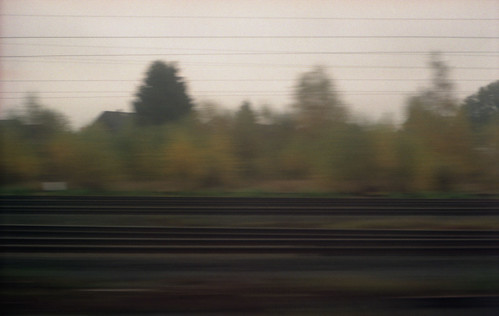
The landscapes are reminiscent of Caspar David Friedrich, a painter explicitly referenced in the film’s final shot, while prefiguring Gerhard Richter in such work as Landschaft bei Koblenz, or Feldweg, Country Path, both 1987, for example. In the DVD commentary, Wenders does state that the film was made in the summer of 1974, but although the trees look green, the weather is almost universally a damp, autumnal grey. Eichendorff’s The Life of a Good-for-nothing possesses an episodic, dream-like narrative where fortune propels the narrator along from Germany through Austria to Rome and back, a number of coincidences happen to him; his only real volition is to keep moving, falling in with different companions for different parts of his journey. It’s a slight book, if the translation I read of it was not abridged (it is a thin volume in the film), which lasted less than a coach journey from London to Bristol, with plenty of time to spare (the electronic version was carelessly made with OCR software, with numerous problems, although I was usually able to tell what the interpretations of the letters were supposed to be). The book would not keep Wilhelm occupied for long, although the first stage of his journey requires a change at Hamburg-Altona. Arriving there, Wilhelm, apparently immersed in the book, looks up to see Laertes with a bloody handkerchief to his nose sitting opposite. Mignon, clutching a large bag sits with him. Wilhelm alights at Hamburg-Altona station, and some wooden shuttering can be seen in the station indicating construction work, which was entirely rebuilt in 1979; when I was there in 2015, there was work on the station again. Changing trains for Bonn, Wilhelm’s gaze is arrested by a woman, who is later revealed to be Therese, an actor, and another character from Goethe’s Wilhelm Meister, taking a train from the adjacent platform. Running in the same direction, there’s a long shot of parallel movement between the trains as Therese looks out towards Wilhelm’s carriage, where Laertes and Mignon reappear to sit opposite Wilhelm again.
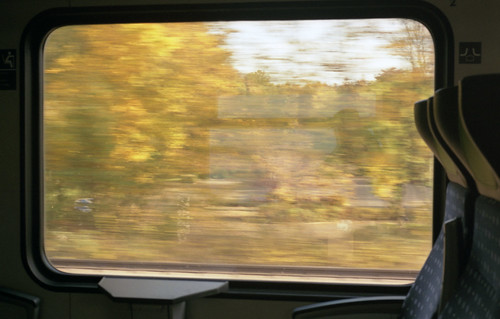
The main change evident in the north German landscape in the forty years since Wrong Move was shot is the presence of renewable energy - not only the wind turbines, but also a number of solar arrays visible from the train. On my trip to and from Glückstadt it was a hazy, sunny morning; the next day, travelling south from Hamburg, to Gelsenkirchen, and then Cologne, mostly in the same direction as Wilhelm, it was very grey, flat and misty, not dissimilar to most of the weather when Wrong Move was filmed. Reading Short Letter, Long Farewell on trains travelling back from Hamburg, the hallucinogenic quality to Handke’s writing, with its plain but insistent description, started to affect me as I finished the book on the final stages of the journey from Cologne to Brussels to London. Perhaps this was due in part to a lack of sleep affecting my perception and emotional state, coupled with a bittersweet feeling of leaving my partner in Germany for a month, returning home by myself. In the book, the description of internal and external phenomena are on a level, and I could imagine myself and the narrator swapping places, looking out of the train window, at the flat landscape, full of autumnal colour, lit by the hazy sun, on the first day of November, with light indistinct bands of clouds; seeing a hot air balloon high up and far away, visualising the occupants looking down to see a train so distant as to be barely moving across the landscape. The balloon’s shape is then echoed by the appearance of a water tower, its upturned cone on the horizon; in a few seconds both are gone.
Bibliography:
Joseph Von Eichendorff, The Life of a Good-for-nothing (Aus dem Leben eines Taugenichts), 1826
Peter Handke, Short Letter, Long Farewell (Kurze Brief zum langen Abschied), translated by Ralph Manheim, New York Review Books, 2009
Johann Wolfgang von Goethe, Wilhelm Meister’s Lehrjahre, translated by Thomas Carlyle, 1795
Julia Knight, New German Cinema: Images of a Generation, Wallflower Press, 2004
Richard W. McCormick, ‘The Writer in Film: Wrong Move’, in The Cinema of Wim Wenders: Image, Narrative and the Post Modern Condition, Roger F. Cook and Gerd Gemünden (editors), Wayne State University Press, 1997
Edward Plater, ‘Taking another look at Wim Wenders's Wrong Move’, Literature/Film Quarterly 30.1, 2002
Wim Wenders, Emotion Pictures, and The Logic Of Images; Essays and Conversations, Faber and Faber, London 1991
See also general bibliography
No comments:
Post a Comment